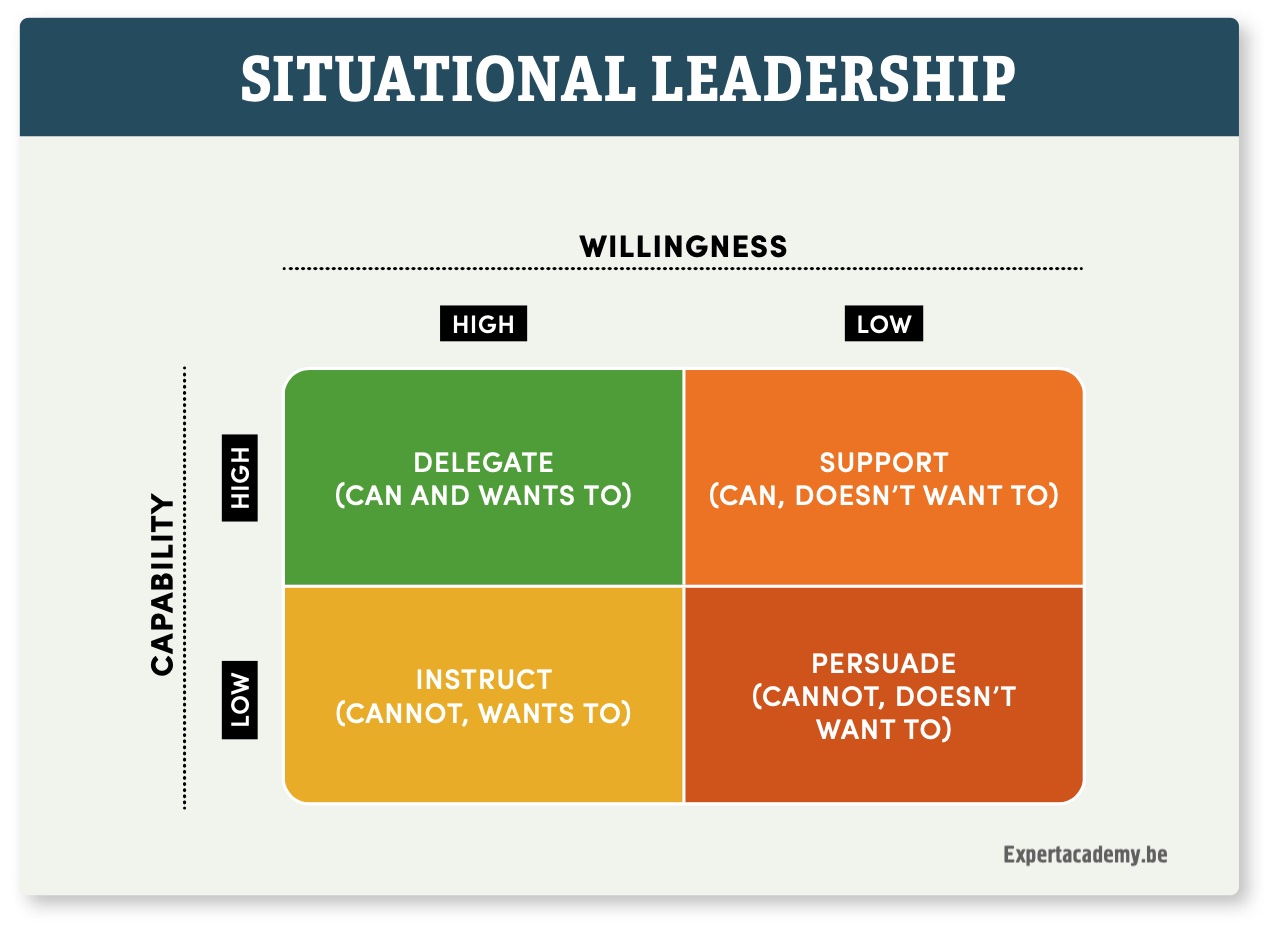Situational Leadership

Situational Leadership is a powerful model that helps managers to manage employees in a task-oriented way while developing their problem-solving abilities. It kills two birds with one stone. How exactly does this model work and how can it help managers in their leadership challenges
In situational leadership, as a manager you look at the capabilities of your employee and the specific task he is going to perform.
Then you analyze the following two elements:
- Is this employee competent to perform the task? (Capable)
- Is this employee also willing to do it? (Motivated)
Competence has to do with "ability. Is the employee capable of performing the task? Does he have the necessary knowledge and skills?
Willingness has to do with two things: does the employee have enough self-confidence to do it? Perhaps he has sufficient knowledge and skills, but no experience at all with the task. A second component to willingness is motivation. Perhaps the employee does not feel like doing this task at all, or he finds the task below his level.
AN EXAMPLE:
Early in the morning at the dispatching office of a transportation company. Erik, a young courier employee, reports to work and is told by his supervisor that Mike is sick. The chief asks Erik if he would like to take over Mike's delivery run. Erik turns his eyes and sighs deeply.
The conclusion of his boss could be that Erik does not feel like it and is acting out, and furthermore is not at all collegial.
In situational leadership, however, you do not judge on behavior, but on the two factors of willingness and ability.
Perhaps Erik would be happy to take over Mike's round, but he does not have the knowledge and skills to do so. After all, Mike's work area is central Brussels with many French-speaking customers and Erik does not speak a word of French. Moreover, Mike drives a rather large truck and Erik only has experience with a light van. Driving such a colossus through the busy center of Brussels is not that easy.
By means of these two questions about competence and willingness, a manager can better assess whether a task is appropriate for an employee or not.
According to the Situational Leadership model, you can lead in roughly two ways:
- Task-oriented (steering behavior)
- Relationship-oriented (supportive behavior)
As a manager you give task-oriented leadership in order to get certain things done. You do this when you indicate, for example, what must be done and how, where and when it must be done.
You give relationship-oriented leadership to strengthen and maintain the bond with your employees.
maintain. To achieve this, you give pats on the back, ask questions or show understanding, for example.
Both types of leadership are necessary. If you only lead in a task-oriented way, sooner or later you will get dissatisfied employees. And if you only lead in a relationship-oriented way, sooner or later you will notice that certain tasks are not carried out or are carried out too late.
So one type of leadership cannot exist without the other. However, you can vary the extent to which you lead in a task-oriented and relationship-oriented way. You can do both more or less. In this way, you can choose from four styles of leadership.
- 1. Instructing
- 2. Persuading
- 3. Supporting
- 4. Delegating

1. INSTRUCTING
This employee wants to, but cannot (yet). What he needs is instruction. You give this instruction by explaining exactly how your employee can do something and for what purpose. You transfer your knowledge as well and clearly as possible. You work step by step: each time you give a bit of instruction, then the application and then instruction again. That way he learns fastest. In the example of the employee with the workload, this style corresponds to the first answer. A supervisor who instructs tells an employee exactly what to do.
2. PERSUADING
An employee at level two cannot yet handle the situation. If you start directing someone like that towards the task at hand, things will go wrong: they won't come through. That is why it pays off if you first pay attention to the relationship. What do you think of it yourself? Because he does not have (all) the knowledge and skills that are needed, focusing on the task remains necessary. So you first let your employee tell you how he himself thinks he can handle it. You listen with attention, ask questions and give compliments when appropriate. This is steering towards the relationship. Then you give your own opinion. This may also be different from what the employee himself has thought up. This is how you steer towards the task.
3. SUPPORTING
This employee has little self-confidence or is not very motivated: he can handle the situation, but is not willing to do so. In both cases, as a manager you do well to steer on the relationship: indicate how important it is that the employee handles this situation, give compliments, let him think about how he should handle the situation and ask about possible private problems. It is important that you do not give substantive guidance, because then there is a danger that his self-confidence and motivation will sink further. A really supportive question is, for example, "What do you think is best? A question such as "do you think that's a good idea?" gives implicitly a negative judgment and therefore does not fit this style.
4. DELEGATING
At this level, employees should be open to a great deal of autonomy. These individuals need little direction or guidance. On the contrary, this can often come across as patronizing or controlling. You can give a lot of space and freedom to these employees. A brief explanation with the desired result is enough. How they achieve that result, they will decide for themselves. You tell your employee what needs to be done, maybe ask briefly for his ideas and give a brief encouragement. But other than that, you leave it at that. This style is short and sweet. Afterwards you do check whether your employee has done his job well. After all, you are responsible for his results.
More impact with situational leadership
The central idea is that you as a manager only have an impact when you adapt your style of leadership to the development level of your employee. The golden rule is that you lead more task-oriented as your employees are less competent for their tasks. And you lead more relationship-oriented as employees are less willing to take on their task. Thus, each developmental level of your employee corresponds to its own style of leadership.
More info: Training Situational Leadership







